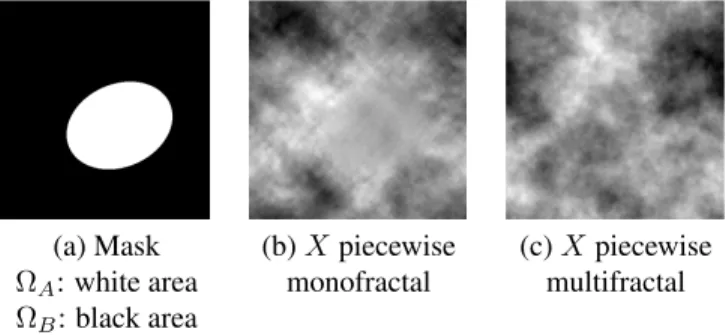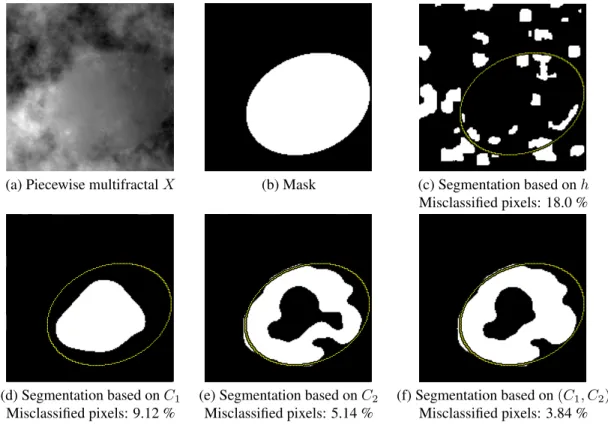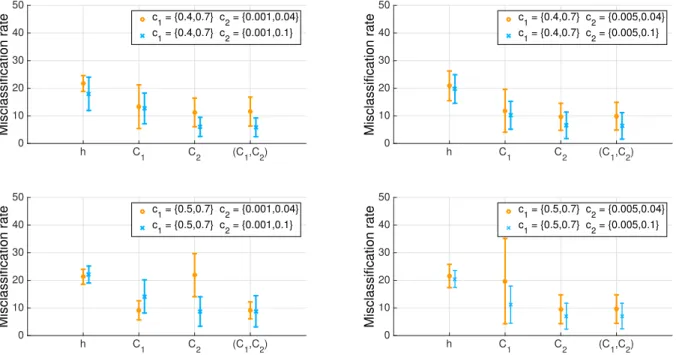HAL Id: hal-01398865
https://hal.archives-ouvertes.fr/hal-01398865
Submitted on 18 Nov 2016
HAL is a multi-disciplinary open access
archive for the deposit and dissemination of
sci-entific research documents, whether they are
pub-lished or not. The documents may come from
teaching and research institutions in France or
abroad, or from public or private research centers.
L’archive ouverte pluridisciplinaire HAL, est
destinée au dépôt et à la diffusion de documents
scientifiques de niveau recherche, publiés ou non,
émanant des établissements d’enseignement et de
recherche français ou étrangers, des laboratoires
publics ou privés.
Multifractal-based texture segmentation using
variational procedure
Jordan Frecon, Nelly Pustelnik, Herwig Wendt, Laurent Condat, Patrice Abry
To cite this version:
Jordan Frecon, Nelly Pustelnik, Herwig Wendt, Laurent Condat, Patrice Abry. Multifractal-based
texture segmentation using variational procedure. IEEE 12th Image, Video, and Multidimensional
Signal Processing Workshop (IVMSP 2016), Jul 2016, Bordeaux, France. pp.1 - 5,
�10.1109/IVM-SPW.2016.7528187�. �hal-01398865�
MULTIFRACTAL-BASED TEXTURE SEGMENTATION USING VARIATIONAL PROCEDURE
Jordan Frecon
1, Nelly Pustelnik
1, Herwig Wendt
2, Laurent Condat
3, Patrice Abry
1,
1
Univ Lyon, Ens de Lyon, Univ Lyon 1, CNRS, Laboratoire de Physique, F-69342 Lyon, France. firstname.lastname@ens-lyon.fr
2
IRIT, CNRS UMR 5505, INP-ENSEEIHT, F-31062 Toulouse, France. herwig.wendt@irit.fr
3
Univ Grenoble Alpes, CNRS, GIPSA-Lab, F-38000 Grenoble, France. laurent.condat@gipsa-lab.grenoble-inp.fr
ABSTRACT
The present contribution aims at segmenting a scale-free tex-ture into different regions, characterized by an a priori (un-known) multifractal spectrum. The multifractal properties are quantified using multiscale quantities C1,jand C2,jthat
quan-tify the evolution along the analysis scales 2jof the empirical mean and variance of a nonlinear transform of wavelet co-efficients. The segmentation is performed jointly across all the scales j on the concatenation of both C1,j and C2,j by
an efficient vectorial extension of a convex relaxation of the piecewise constant Potts segmentation problem. We provide comparisons with the scalar segmentation of the H¨older expo-nent as well as independent vectorial segmentations over C1
and C2.
Index Terms— Local regularity, multifractal spectrum, segmentation, convex optimization, wavelet leaders
1. INTRODUCTION
Recent contributions in image processing highlighted the need of segmentation techniques for scale-free textures anal-ysis [1, 2, 3]. The possible applications go from texture medical images such as the bone study [4] to art investiga-tions [5, 6].
Scale-free behavior is captured with local regularity, tech-nically measured via the concept of H¨older exponent [7]. First studies based on the estimation of this quantity can be traced back to [8] where local regularity was assumed homogeneous throughout the image (i.e., monofractal). Recent contribu-tions have considered a more realistic model, where the local regularity may be heterogeneous throughout the image (i.e, piecewise monofractal). This further increases the complex-ity of the estimation procedure since it additionnaly amounts in segmenting the image into a priori unknown regions where the local regularity can be considered homogeneous.. Among numerous techniques for image segmentation, some efficient variational approaches have recently been designed relying on the use of the total variation [9, 1, 3, 10]. The good results of
Work supported by GdR 720 ISIS under the junior research project GALILEO, ANR AMATIS grant #112432, 2010-2014, and CNRS Imag’in project under grant 2015OPTIMISME.
these estimation and segmentation techniques (on simulated and real data) thus pave the way for considering more com-plex piecewise scale-free models. This is the subject of the present contribution.
We aim to go further by proposing a segmentation method for piecewise multifractal processes analysis, thus allowing a richer modeling of real-world textures. The multifractal for-malism detailled Section 2 relies on the local estimation of multiscale quantities in place of the local regularity. It is com-bined with a joint vectorial segmentation procedure whose al-gorithmic solution is briefly summarized in Section 3. Esti-mation performance on synthetic results is reported in Sec-tion 4. Comparisons with state-of-the-art methods are also provided.
2. MULTIFRACTAL ANALYSIS
Piecewise mono/multi-fractal. We denote X = (X`)1≤`≤N
the scale-free image to analyze, which has N pixels. Its local regularity can be quantified by the H¨older exponent [7] de-noted by h = (h`)1≤`≤N. While large h`points to a locally
smooth portion of the field, low h`indicates local high
irreg-ularity. Two examples of X are provided in Figure 1(b)-(c). On the one hand, in Figure 1(b), X models a piecewise monofractal process having two different values of h`, i.e.
(∀` ∈ ΩA) h`= hA, (1)
(∀` ∈ ΩB) h`= hB, (2)
with hA < hB and Ω = ΩA∪ ΩB being separable in two
distinct areas, i.e., ΩA∩ ΩB = ∅, according to the mask
pre-sented in Figure 1 (a). A smoother behavior is thus observed for ` ∈ ΩAthan for ` ∈ ΩB.
On the other hand, in Figure 1 (c), X models a piecewise multifractal process where h` may locally vary both within
ΩA and ΩB. Therefore, the multifractal spectrum D(h),
which describes local regularity fluctuations, is not reduced to a Dirac (cf. e.g., [7, 11, 12] for details), and
(∀` ∈ ΩA) h`can be described by DA(h) (3)
(a) Mask (b) X piecewise (c) X piecewise ΩA: white area monofractal multifractal
ΩB: black area
Fig. 1. Examples of scale-free textures.
The aim of multifractal analysis is to estimate D(h). For prac-tical purposes, the multifractal spectrum can often be approx-imated as a parabola: D(h) = 2 + (h − c1)2/(2c2). Here,
we follow the efficient procedure proposed in [12] based on wavelet-leadercoefficients [7].
Wavelet-leader coefficients. We denote d(m)j,k = hX, ψ (m) j,k i
the (L1-normalized) 2D discrete wavelet coefficients of X at location k = 2−j`, at scale 2j with j ∈ {1, . . . , J }, and where m stands for the horizontal/vertical/diagonal subband. For a detailed definition of the 2D-DWT, readers are referred to e.g., [13]. The wavelet leader coefficient Lj,k, located
around position ` = 2jk, is defined as the local supremum of
all wavelet coefficients taken within a spatial neighborhood across all finer scales 2j0 ≤ 2j, that is,
Lj,k= sup m=1,2,3, λj0 ,k0⊂Λj,k
|d(m)j0,k0|, (5)
with λj,k= [k2j, (k+1)2j), and Λj,k=Sp∈{−1,0,1}2λj,k+p.
An illustration is provided in Figure 2 where Lj,kis indicated
with a black cross and the neighborhood Λj,kis displayed in
red.
H¨older exponent. The H¨older exponent can be obtained by a linear regression of wavelet-leader coefficients as follows:
hk=
X
j∈{1,...,J }
wj,klog2Lj,k, (6)
where the wj,kmodel regression weights [11].
Multifractal spectrum. The multifractal spectrum can be obtained by multiscale quantities C1,j ∈ RN and C2,j ∈ RN
defined as the sample estimates of the first and second cumu-lant of log2Ljat each given scale 2j. It has been shown that
C1,j and C2,j are related to the multifractal spectrum D(h)
via the coefficients c1and c2as follows [12]:
EC1,j = c01+ c1ln 2j, (7)
EC2,j = c02+ c2ln 2j. (8)
Fig. 2. waveleter-leader coefficients. The wavelet leader coefficient (black cross) is defined as the local supremum of all wavelet coefficients taken within a spatial neighborhood across all finer scales (red)
To evaluate changes in multifractal spectrum, one could nat-urally consider estimating C1,j and C2,j locally in a
neigh-borhood of each pixel `, estimate the corresponding local pa-rameters c1and c2, and then perform a vectorial segmentation
of (c1, c2). However, this relies on the strong assumption that
real-world textures follow precisely the scaling behaviors pre-scribed in Eqs. (7) and (8) above. In the present contribution, it has been chosen to relax this requirement and to directly perform a vectorial segmentation over multiscale quantities C1,j and C2,j, possibly smoothed.
3. VECTORIAL SEGMENTATION
We propose to follow segmentation procedure ideas that per-form well for piecewise mono/multi-fractal estimation [2]. The vectorial segmentation procedure is based on a convex relaxation of the piecewise constant Potts segmentation prob-lem [9, 14]. Here we consider the extension to joint vectorial segmentation proposed in [9] for image labelling. In what fol-lows, Y = (Ym)1≤m≤M ∈ RN ×M can either model h (i.e.,
M = 1), C1 or C2 (i.e., M = J ), or their concatenation
(C1, C2) (i.e., M = 2J ).
Problem formulation. The labeling procedure of Y into Q level sets can be formalized as a minimization problem where Q + 1 binary images Θ = (θq)1≤q≤(Q+1) ∈ RN ×Q+1 are
estimated such that
min Θ Q X q=1 (θq−θq+1)> M X m=1 (Ym−vq,m)2+λ Q X q=1 TV(θq−θq+1) subject to θ1= 1, θQ+1= 0, 1 ≥ θ2≥ . . . ≥ θQ≥ 0, (9)
with λ > 0 and where TV denotes the usual total-variation penalization as defined in [15], i.e., for every θ ∈ RN,
TV(θ) =
N
X
`=1
k(Dθ)`k2, (10)
where D ∈ R2N ×Nstands for the discrete horizontal/vertical difference operator and thus (Dθ)` ∈ R2. The choice of
vq,m∈ R will be discussed further.
The Q resulting labelling areas (Ω1, . . . , ΩQ) are obtained
from the binary images (θq− θq+1)1≤q≤Qas follows:
(∀` ∈ Ω) θq,`− θq+1,`=
(
1, if ` ∈ Ωq,
0, otherwise. (11) The first term in (9) is a data fidelity term allowing to impose similar properties within each area Ωq. The second
term imposes the regularity for each labelling area Ωq. The
smaller is λ the higher is the granularity of Ωq.
Algorithmic solution. In order to efficiently estimate Θ we use the algorithmic strategy proposed in [16] that consists in using a proximal splitting method coupled with an efficient strategy to compute the involved proximal operators. The reader could refer to [9, 16] for details regarding the algo-rithmic strategy for solving (9).
4. EXPERIMENTS
Experimental setting. Performance of the proposed seg-mentation procedure are assessed on synthetic data, numeri-cally produced by inclusion of a 2D MRW patch ΩA[17] into
a 2D-MRW background ΩB with different multifractal
pa-rameters. Patch and background (Figure 3 (b)) have been nor-malized to ensure that the local variance does not depend on the image location. An illustration is provided in Figure 3 (a) where the background parameters (c1, c2) = (0.7, 0.1) and
the patch parameters (c1, c2) = (0.4, 0.005).
The wavelet leader coefficients are estimated using a stan-dard 2D-DWT with orthonormal tensor product Daubechies mother wavelets with 2 vanishing moments.
In our simulation, we have set Q = 2, λ = 1 and J = 3. For every component m ∈ {1, . . . M }, (vq,m)1≤q≤Qare
ini-tially chosen to be equally distributed between the minimum and maximum values of Ym. Then, an alternate minimization
of (9) and re-estimation of the (vq,m)1≤q≤Q is performed 5
times.
Scalar vs. vectorial segmentation. The scalar segmentation of Y = h, originally envisaged for the analysis of piecewise monofractal processes [3], is illustrated in Figure 3-(c)). We observe that it yields poor results. Indeed, since the process is multifractal, every h of the support of D(h) is present in any open interval of the trajectory for finite resolution data. The local estimation of h is hence not very meaningful. In addition, since DAand DBoverlap, the sole feature h can not
permit to discriminate between ΩA and ΩB. This limitation
thus shows the need of investigating multiscale quantities re-lated to the multifractal spectrum, namely C1and C2. Such
a strategy has been previously investigated in [2] with a dif-ferent algorithmic solution involving a difdif-ferent segmentation for each component m ∈ {1, . . . , M }.
Segmentation performance. For the same patch displayed in Figure 3 (b), we have considered eight configurations re-ported in Figure 4 and defined as follow. The top (resp. bot-tom) plots correspond to a large (resp. small) difference of c1
between ΩAand ΩB. The left (resp. right) plots model large
(resp. small) difference of c2between ΩAand ΩB. In
addi-tion, we have further investigated the impact of c2: results in
orange correspond to two tight multifractal spectrum DAand
DB (i.e., small c2on both ΩAand ΩB) whereas the blue one
models one tight DA(i.e., small c2on ΩA) and a widespread
DB (i.e., large c2on ΩB). Estimation performance are
quan-tified in terms of misclassified pixels percentage over 20 real-izations for all the different inputs Y .
Unsurprisingly, using Y = h always leads to poor seg-mentation performance. In addition, all these experiments reproduce the expected behavior that the larger is the dif-ference of c1 (resp. c2) between ΩA and ΩB, the better are
the segmentation performance associated to Y = C1 (resp.
Y = C2). However, a closer inspection shows that a larger
difference in c1does not necessarily lead to better
segmen-tation results for Y = C2 (see the orange line in both left
plots). Overall, we observe that there is always an interest in combining the information of both C1and C2.
Finally, it is worth noticing that the scalar segmentation of h is only 2 times faster than the vectorial ones either based on C1, C2or (C1, C2). Experimentally, it takes less than 1
minute per image of size N = 29× 29.
5. CONCLUSIONS AND PERSPECTIVES
In this work, we have designed an analysis procedure for deal-ing with piecewise multifractal processes. We have shown the need of considering multiscale quantities C1 and C2 rather
than the sole H¨older exponent usually considered for piece-wise monofractal processes. An efficient joint vectorial seg-mentation procedure is proposed and yields satisfactory per-formance when applied to (C1, C2).
However, the proposed segmentation procedure rely on the strong assumption that θq,1− θq+1,1 = . . . = θq,M −
θq+1,M. Therefore, the performance are very sensitive to the
arbitrary choice and order of the level sets vq,m. In order
to alleviate this limitation, different regularization terms are under current investigation to provide a more flexible joint vectorial segmentation strategy.
(a) Piecewise multifractal X (b) Mask (c) Segmentation based on h Misclassified pixels: 18.0 %
(d) Segmentation based on C1 (e) Segmentation based on C2 (f) Segmentation based on (C1, C2)
Misclassified pixels: 9.12 % Misclassified pixels: 5.14 % Misclassified pixels: 3.84 %
Fig. 3. Illustration of the segmentation results. The piecewise multifractal image X is presented in (a) and has been generated from the mask (b). The scalar segmentation result obtained from h is displayed in (c). The vectorial segmentation results based on C1, C2and (C1, C2) are respectively presented in (d), (e) and (f).
6. REFERENCES
[1] C. Nafornita, A. Isar, and J. D. B. Nelson, “Semi-local Hurst estimation via generalised lasso and dual-tree complex wavelets,” in Proc. Int. Conf. Image Pro-cess., Paris, France, Oct. 27-30 2014, pp. 2689–2693.
[2] J. Frecon, N. Pustelnik, H. Wendt, and P. Abry, “Mul-tivariate optimization for multifractal-based texture seg-mentation,” in Proc. Int. Conf. Image Process., Quebec City, Canada, Sept, 27-30 2015.
[3] N. Pustelnik, H. Wendt, P. Abry, and N Dobigeon, “Local regularity, wavelet leaders and total variation based procedures for texture segmentation,,” Tech. Rep., arXiv:1504.05776, 2016.
[4] C.L. Benhamou, S. Poupon, E. Lespessailles, S. Loiseau, R. Jennane, V. Siroux, W. J. Ohley, and L. Pothuaud, “Fractal analysis of radiographic trabecular bone texture and bone mineral density: two complementary parameters related to osteoporotic fractures,” J. Bone Miner. Res., vol. 16, no. 4, pp. 697–704, 2001.
[5] P. Abry, S. Jaffard, and H. Wendt, “When Van Gogh meets Mandelbrot: Multifractal classification of
paint-ing’s texture,” Signal Process., vol. 93, no. 3, pp. 554– 572, 2013.
[6] C. R. Johnson, P. Messier, W. A. Sethares, A. G. Klein, C. Brown, P. Klausmeyer, P. Abry, S. Jaffard, H. Wendt, S. G. Roux, N. Pustelnik, N. van Noord, L. van der Maaten, E. Postma, J. Coddington, L. A. Daffner, H. Murata, H. Wilhelm, S. Wod, and M. Messier, “Pur-suing automated classification of historic photographic papers from raking light photomicrographs.,” Journal of the American Institute for Conservation, vol. 53, no. 3, pp. 159–170, 2014.
[7] S. Jaffard, “Wavelet techniques in multifractal analy-sis,” in Fractal Geometry and Applications: A Jubilee of Benoˆıt Mandelbrot, M. Lapidus and M. van Franken-huijsen Eds., Proceedings of Symposia in Pure Math-ematics, M. Lapidus and M. van Frankenhuijsen, Eds. 2004, vol. 72, pp. 91–152, AMS.
[8] S. G. Roux, A. Arneodo, and N. Decoster, “A wavelet-based method for multifractal image analysis. III. Ap-plications to high-resolution satellite images of cloud structure,” Eur. Phys. J. B, vol. 15, no. 4, pp. 765–786, 2000.
h C 1 C2 (C1,C2) Misclassification rate 0 10 20 30 40 50 c 1 = {0.4,0.7} c2 = {0.001,0.04} c 1 = {0.4,0.7} c2 = {0.001,0.1} h C 1 C2 (C1,C2) Misclassification rate 0 10 20 30 40 50 c 1 = {0.4,0.7} c2 = {0.005,0.04} c 1 = {0.4,0.7} c2 = {0.005,0.1} h C 1 C2 (C1,C2) Misclassification rate 0 10 20 30 40 50 c 1 = {0.5,0.7} c2 = {0.001,0.04} c 1 = {0.5,0.7} c2 = {0.001,0.1} h C 1 C2 (C1,C2) Misclassification rate 0 10 20 30 40 50 c 1 = {0.5,0.7} c2 = {0.005,0.04} c 1 = {0.5,0.7} c2 = {0.005,0.1}
Fig. 4. Segmentation performance. Comparison of the segmentation performance is quantified in terms of mean misclassifi-cation rate depending on the choice of the input Y represented along the x-axis (error bar indicate the standard deviation). Each plot represent two configurations (blue and orange) of c1and c2on ΩAand ΩB.
approach to minimal partitions,” SIAM J. Imaging Sci., vol. 5, no. 4, pp. 1113–1158, 2012.
[10] J.D.B. Nelson, C. Nafornta, and A. Isar, “Semi-local scaling exponent estimation with box-penalty con-straints and total-variation regularization,” IEEE Trans. Image Process., vol. 25, no. 6, pp. 3167–3181, Apr. 2016.
[11] H. Wendt, P. Abry, and S. Jaffard, “Bootstrap for empir-ical multifractal analysis,” IEEE Signal Process. Mag., vol. 24, no. 4, pp. 38–48, Jul. 2007.
[12] H. Wendt, S.G. Roux, P. Abry, and S. Jaffard, “Wavelet leaders and bootstrap for multifractal analysis of im-ages,” Signal Proces., vol. 89, pp. 1100–1114, 2009.
[13] S. Mallat, A wavelet tour of signal processing, Aca-demic Press, San Diego, USA, 1997.
[14] M. Storath and A. Weinmann, “Fast partitioning of vector-valued images,” SIAM J. Imaging Sci., vol. 7, no. 3, pp. 1826–1852, 2014.
[15] A. Chambolle, “An algorithm for total variation mini-mization and applications,” J. Math. Imag. Vis., vol. 20, no. 1-2, pp. 89–97, Jan. 2004.
[16] L. Condat and N. Pustelnik, “Segmentation d’image par optimisation proximale,” in Proc. GRETSI, Lyon, France, September 8-11, 2015, in French.
[17] Raoul Robert, Vincent Vargas, et al., “Gaussian mul-tiplicative chaos revisited,” The Annals of Probability, vol. 38, no. 2, pp. 605–631, 2010.


